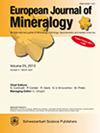Pleysteinite, [(H2O)0.5K0.5]2Mn2Al3(PO4)4F2(H2O)10 ⋅ 4H2O, the Al analogue of benyacarite, from the Hagendorf-Süd pegmatite, Oberpfalz, Bavaria, Germany
IF 1.7
3区 地球科学
Q2 MINERALOGY
引用次数: 3
Abstract
Abstract. Pleysteinite, [(H2O)0.5K0.5]2Mn2Al3(PO4)4F2(H2O)10 ⚫ 4H2O, is the aluminium analogue of benyacarite, from the Hagendorf-Süd pegmatite, Oberpfalz, Bavaria, Germany. It was found in specimens of altered zwieselite, in association with nordgauite, fluellite, rockbridgeite, pyrite and columbite. Pleysteinite occurs as isolated and small aggregates of colourless, stubby prisms that are typically 10 to 30 µm wide and up to 100 µm long. The crystals are flattened on {010} and bounded by {111}, {100} and {001} planes. The calculated density is 2.34 g cm−3. Optically, pleysteinite crystals are biaxial (+), with α=1.566(2), β=1.580(2), γ=1.600(2) (measured in white light) and 2V(meas.) = 80(1)∘. The empirical formula from electron microprobe analyses and structure refinement is [(H2O)0.50K0.50]2(Mn1.20Mg0.49Fe0.272+Zn0.05)∑2.01(Al1.63Fe0.203+Ti0.194+)∑2.02(Al0.56Ti0.444+) (PO4)4.02[F0.58O0.31(OH)0.11]2(H2O)10 ⚫ 3.92H2O. Pleysteinite has orthorhombic symmetry, with space group Pbca and unit-cell parameters a = 10.4133(8) Å, b=20.5242(17) Å, c=12.2651(13) Å, V=2621.4(4) Å3 and Z=4. The crystal structure was refined using single-crystal data to wRobs=0.054 for 1692 reflections with I>3σ(I). The crystal structure contains corner-connected linear trimers of Al-centred octahedra that share corners with PO4 tetrahedra to form 10-member rings parallel to (010). K+ cations and water molecules are located in the rings. Additional corner-sharing of the PO4 tetrahedra with Mn(H2O)4O2 octahedra occurs along [010] to complete the 3D framework structure.Pleysteinite,[(H2O)0.5K0.5]2Mn2Al3(PO4)4F2(H2O)10 ⋅ 4H2O,benyacarite的Al类似物,来自德国巴伐利亚州奥伯普法尔茨Hagendorf-Süd伟晶岩
摘要Pleysteinite,[(H2O)0.5K0.5]2Mn2Al3(PO4)4F2(H2O)10 ⚫ 4H2O,是benyacarite的铝类似物,来自德国巴伐利亚州Oberpfalz的Hagendorf-Süd伟晶岩。它是在蚀变zwieseite的样品中发现的,与北欧绿泥石、流橄榄岩、岩桥绿泥石、黄铁矿和铌铁矿有关。Pleysteinite以无色、短粗棱柱的孤立小聚集体的形式出现,通常为10至30 µm宽,最大可达100 µm长。晶体在{010}上被平坦化,并由{111}、{100}和{001}平面界定。计算密度为2.34 g cm−3。在光学上,多晶闪锌矿晶体为双轴(+),α=1.566(2),β=1.580(2)、γ=1.600(2)(在白光中测量)和2V(测量值) = 80(1)∘。电子探针分析和结构细化的经验公式为[(H2O)0.50K0.50]2(Mn1.20Mg0.49Fe0.272+Zn0.05)∑2.01(Al1.63Fe0.203+Ti0.194+)∑2.02(Al0.56Ti0.444+)(PO4)4.02[F0.58O0.31(OH)0.11]2(H2O)10 ⚫ 3.92H2O。Pleysteinite具有正交对称性,空间群Pbca,晶胞参数a = 10.4133(8) Å,b=20.5242(17) Å,c=12.2651(13) Å,V=2621.4(4) Å3和Z=4。对1692次I>3σ(I)的反射,利用单晶数据将晶体结构细化为wRobs=0.054。晶体结构包含以Al为中心的八面体的角连接的近三聚体,其与PO4四面体共享角以形成平行于(010)的10元环。K+阳离子和水分子位于环中。PO4四面体与Mn(H2O)4O2八面体沿[010]发生额外的角共享,以完成3D框架结构。
本文章由计算机程序翻译,如有差异,请以英文原文为准。
求助全文
约1分钟内获得全文
求助全文
来源期刊
CiteScore
2.80
自引率
9.50%
发文量
40
审稿时长
6-12 weeks
期刊介绍:
EJM was founded to reach a large audience on an international scale and also for achieving closer cooperation of European countries in the publication of scientific results. The founding societies have set themselves the task of publishing a journal of the highest standard open to all scientists performing mineralogical research in the widest sense of the term, all over the world. Contributions will therefore be published primarily in English.
EJM publishes original papers, review articles and letters dealing with the mineralogical sciences s.l., primarily mineralogy, petrology, geochemistry, crystallography and ore deposits, but also biomineralogy, environmental, applied and technical mineralogy. Nevertheless, papers in any related field, including cultural heritage, will be considered.

 求助内容:
求助内容: 应助结果提醒方式:
应助结果提醒方式:


